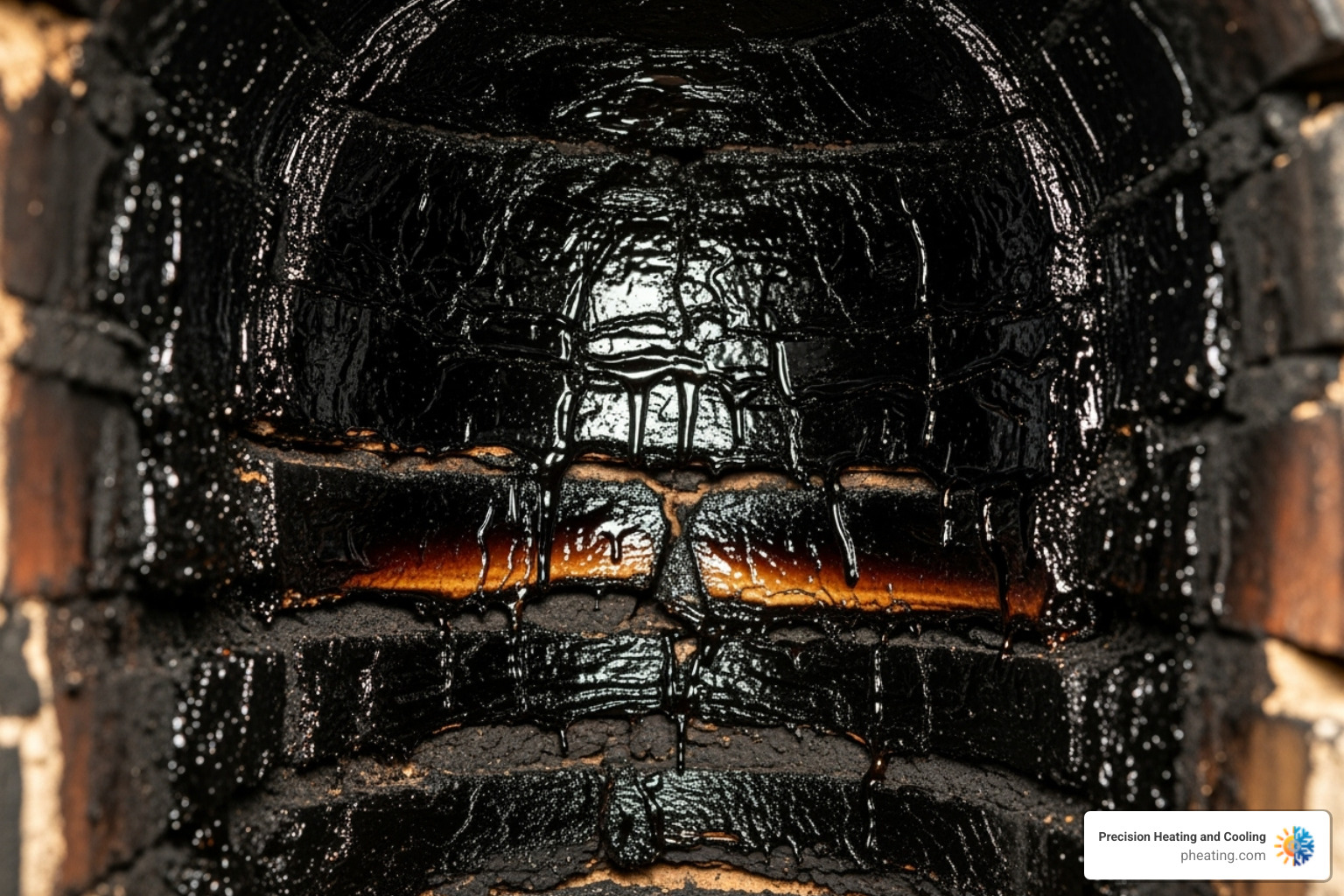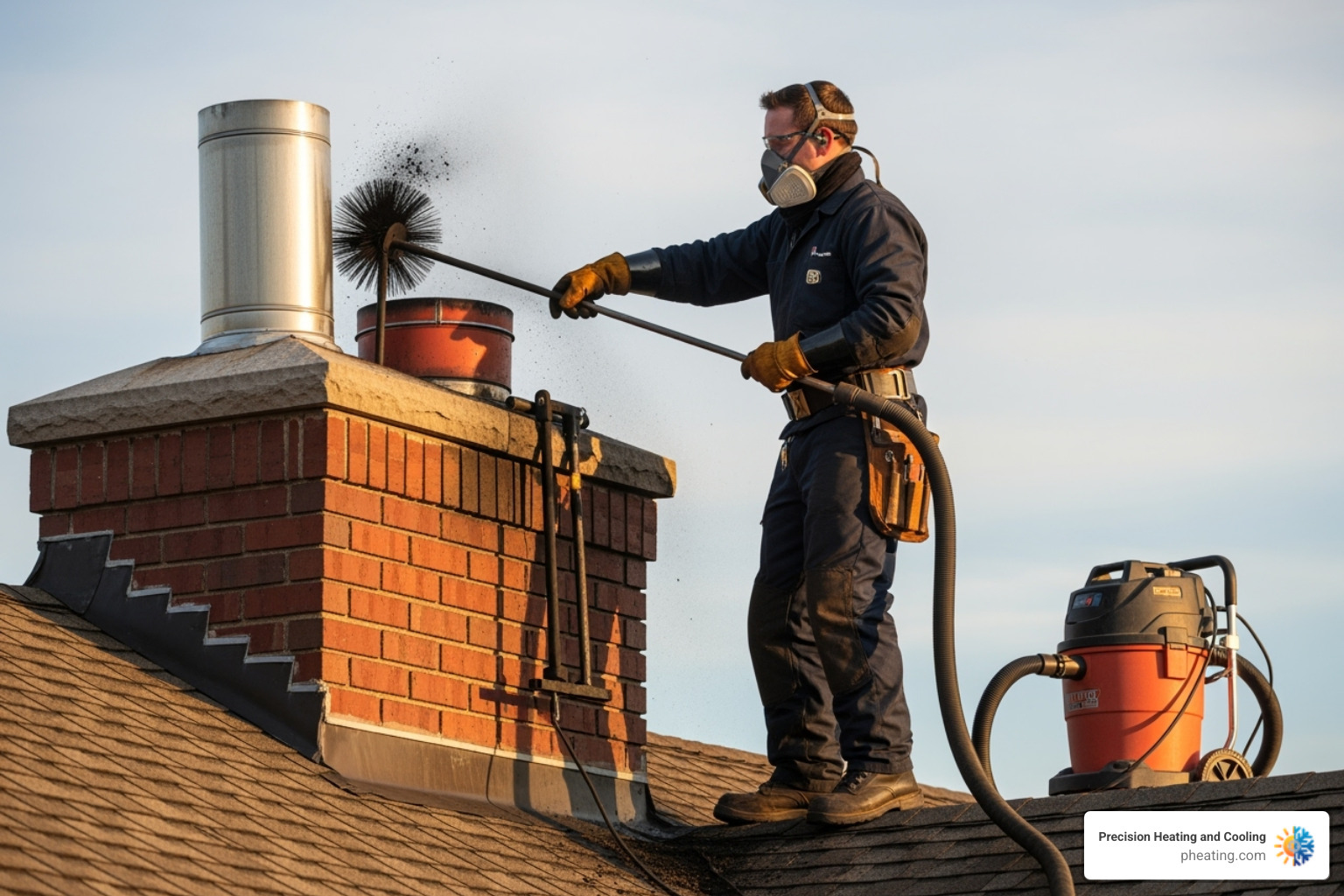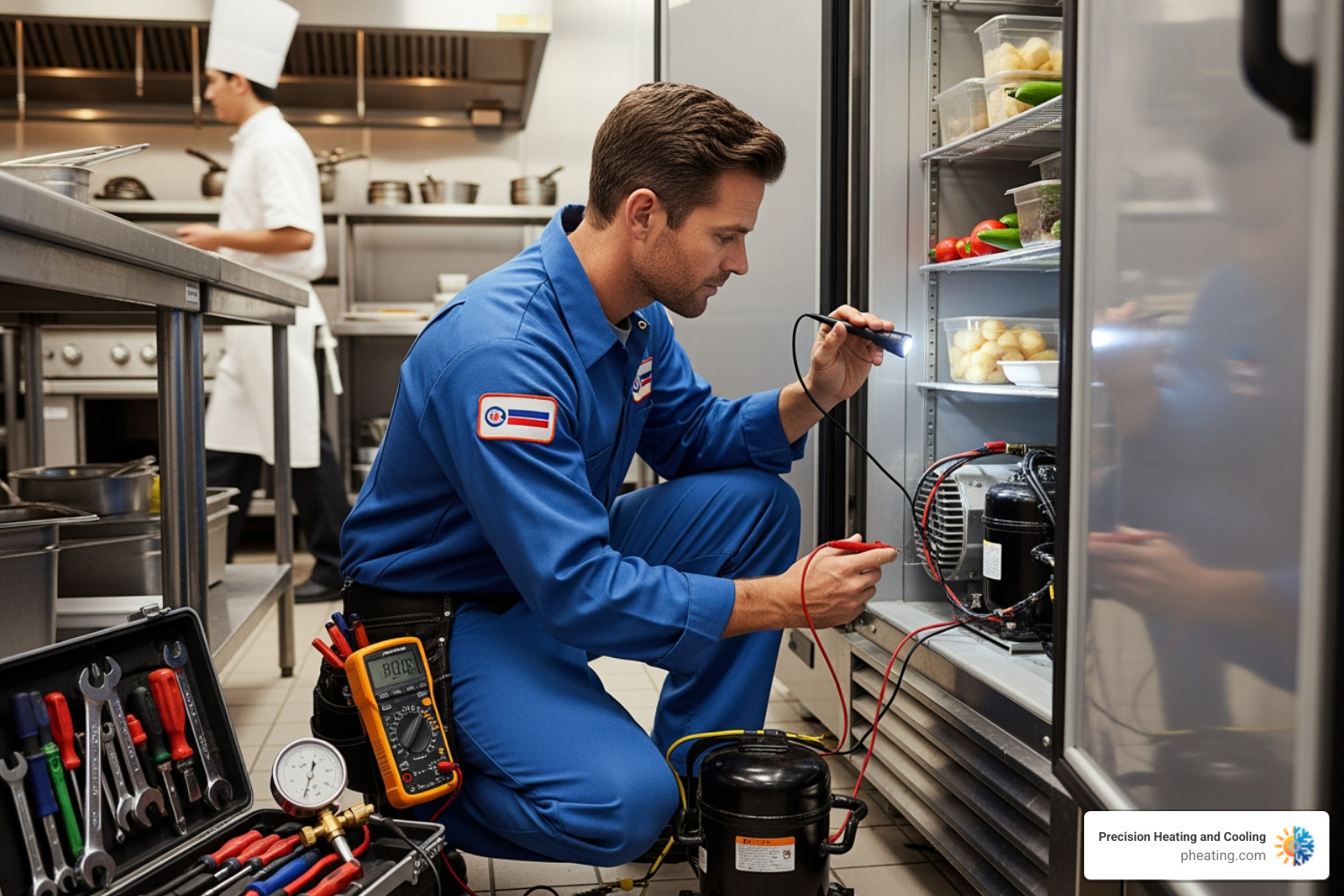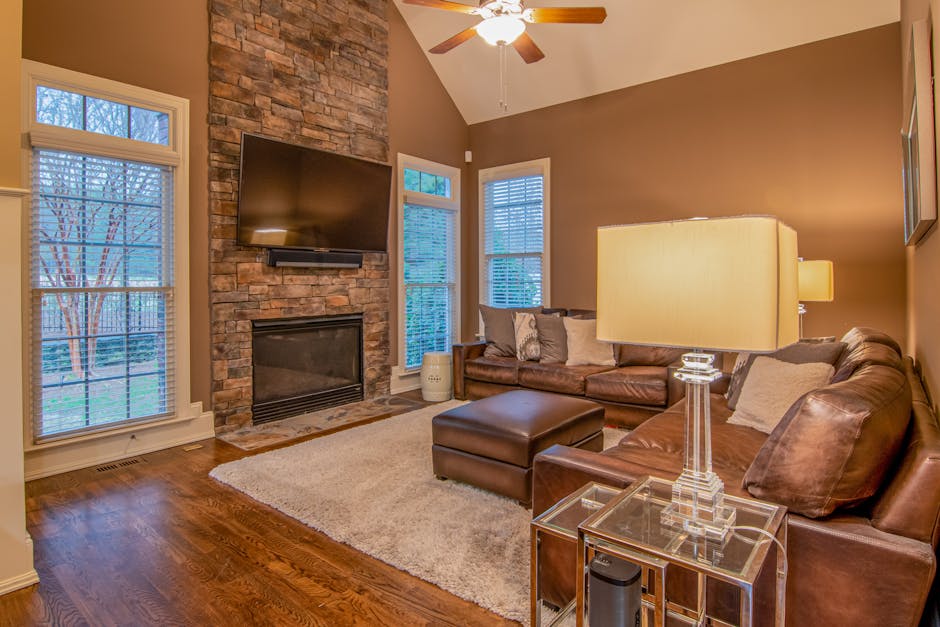Why Chimney Cleaning Safety Can Save Your Life and Home
Chimney cleaning safety is absolutely critical for preventing house fires and carbon monoxide poisoning. More than 25,000 chimney fires occur annually in the US, causing over $125 million in property damage. The primary culprit? Creosote buildup - a highly flammable substance that accumulates inside your chimney every time you burn wood.
Here are the essential chimney safety basics every homeowner needs to know:
- Clean annually - Have your chimney inspected and cleaned at least once per year
- Watch for warning signs - Unpleasant odors, visible soot, poor draft, or smoke entering your home
- Understand the dangers - Creosote buildup can ignite at 2,000°F, while blocked flues can leak deadly carbon monoxide
- Use professionals - DIY cleaning risks falls, incomplete removal, and missing structural problems
- Burn proper fuel - Only seasoned hardwood to minimize dangerous creosote formation
Even a small amount of creosote - just 1/8 inch thick - represents a serious fire hazard according to safety experts. A dirty chimney doesn't just risk fires; it can also block proper ventilation, forcing harmful gases like carbon monoxide back into your living space instead of safely outside.
The good news? Most chimney-related accidents are completely preventable with proper maintenance and safety practices.
I'm Tony Lara, and in my years working in the HVAC industry, I've seen how proper maintenance prevents dangerous situations while neglect leads to costly emergencies. Chimney cleaning safety isn't just about following rules - it's about protecting your family and your biggest investment: your home.

Understanding the Dangers: Why Chimney Cleaning is Non-Negotiable
When you light that first fire of the season, it feels like pure magic - the crackling warmth, the dancing flames, the cozy atmosphere. But behind this comfort lies a responsibility that could literally save your life. Chimney cleaning safety isn't just about maintenance; it's about preventing disasters that happen to thousands of families every year.
Let me share something that might surprise you: most homeowners have no idea how dangerous their neglected chimney has become until it's too late.
The Primary Fire Hazard: Creosote Buildup
Every time you burn wood, you're creating creosote - a sticky, tar-like substance that clings to your chimney walls like glue. Think of it as nature's napalm because that's essentially what it becomes when it ignites.

Creosote develops in three distinct stages, each more dangerous than the last. Stage 1 starts as flaky, soot-like deposits that brush away easily - this is your chimney's way of giving you a gentle warning. Stage 2 becomes harder and more tar-like, requiring serious scraping to remove. But Stage 3 is the real nightmare: a glazed, rock-hard coating that's so flammable and difficult to remove that you might need to replace your entire chimney liner.
Here's the scary part: just 1/8 inch of creosote buildup represents a serious fire hazard. When this stuff ignites, it burns at a scorching 2,000 degrees Fahrenheit - hot enough to crack your chimney and spread fire to your home's structure.
The statistics are sobering. More than 25,000 chimney fires happen every year in the United States, causing over $125 million in property damage. That's why understanding more info on creosote from the CDC is crucial for protecting your family.
The Silent Threat: Carbon monoxide (CO) Poisoning
If chimney fires are the dramatic villain, carbon monoxide is the silent assassin. This colorless, odorless gas is produced every time you burn fuel, and when your chimney can't properly vent it outside, it backs up into your living space.
Carbon monoxide poisoning symptoms are sneaky - they often feel like the flu. You might experience headaches, dizziness, nausea, and fatigue without realizing your chimney is slowly poisoning you. In high concentrations, CO can be fatal, and you'll never see it coming.
A blocked or damaged chimney creates the perfect storm for improper ventilation. Much like dryer vent cleaning for home safety prevents hazards, maintaining a clean chimney ensures deadly gases exit your home instead of entering it.
This is why CO detectors on every level of your home aren't optional - they're lifesavers.
Efficiency and Longevity
Beyond the life-threatening dangers, a dirty chimney is literally burning your money. When creosote and soot restrict airflow, your fireplace or stove works overtime trying to breathe. It's like trying to run a marathon while breathing through a straw.
Poor draft means poor combustion, which translates to less heat reaching your room and more energy wasted up the chimney. Your heating bills climb while your comfort drops - nobody wants that equation.
But the financial pain doesn't stop there. Creosote is corrosive, slowly eating away at your chimney liner and masonry like acid. What starts as a simple cleaning job can become thousands of dollars in structural repairs if you wait too long.
Regular cleaning keeps your system running efficiently, extends your fireplace's lifespan, and prevents the kind of expensive surprises that can wreck your budget. It's one of those situations where spending a little now saves you a fortune later.
The bottom line? Chimney cleaning safety isn't negotiable if you want to protect your family, your home, and your wallet.
Your Annual Inspection and Maintenance Checklist
Think of your chimney like your car – it needs regular check-ups to run safely and efficiently. The difference is, when your chimney "breaks down," the consequences can be far more serious than being stranded on the roadside. That's why chimney cleaning safety starts with a solid maintenance routine.
How Often to Inspect and Clean

The CSIA recommends annual inspections for every chimney, regardless of how often you use it. Yes, even if your fireplace is more decorative than functional! Here's why: chimneys don't take summer vacations. While you're enjoying warm weather, animals may be moving in upstairs, birds might be building nests, or weather damage could be slowly developing.
The frequency of actual cleaning depends on several factors. If you're burning fires regularly throughout the winter, you'll likely need cleaning every year. The type of wood you burn matters too – seasoned hardwood creates less creosote than green or softwood. But even light users benefit from that annual inspection to catch problems early.
Signs Your Chimney Needs Attention
Your chimney is pretty good at sending distress signals if you know what to look for. Strong, smoky odors during humid weather are often the first clue – that's creosote buildup making itself known. It's especially noticeable in summer when warm, moist air draws those odors down into your living space.
Visible soot or black deposits around your damper or firebox are obvious red flags. If you can see it, there's definitely more you can't see higher up in the flue. Poor draft is another telltale sign – when smoke backs up into your room instead of going up the chimney, something's blocking the path.
Don't ignore unusual sounds either. Chirping, scratching, or rustling noises often mean you've got unwanted tenants. Falling debris in your firebox – whether it's soot, creosote chunks, or even pieces of flue liner – signals that things are deteriorating above.
Difficulty starting or maintaining fires can indicate restricted airflow from buildup. Outside your home, cracks in the masonry, damaged mortar, or a rusty chimney cap all point to problems that need professional attention. For a comprehensive look at warning signs, check out our guide on Reasons to Schedule a Chimney Cleaning.
What a Professional Inspects
When a professional chimney sweep visits your home, they're doing detective work from top to bottom. They'll examine your flue liner – the protective barrier that keeps combustion byproducts contained and prevents heat from reaching combustible parts of your home. Cracks or gaps here are serious safety concerns.
The damper gets a thorough check too. This mechanism needs to open fully for proper draft and seal tightly when not in use to prevent heat loss and keep animals out. They'll inspect your smoke chamber above the firebox, looking for proper construction and any damage that could affect performance.
Your firebox – where the actual fire burns – gets scrutinized for cracked or loose refractory bricks and deteriorating mortar. Up top, they'll check your chimney cap to ensure it's keeping rain, snow, and critters out while allowing smoke to escape freely.
The exterior masonry tells its own story about your chimney's health. Water damage, settling, and freeze-thaw cycles all leave their marks. Finally, they'll examine the flashing – those metal seals between your chimney and roof that prevent water from sneaking into your home.
This comprehensive approach ensures that chimney cleaning safety isn't just about removing creosote – it's about maintaining your entire chimney system for years of safe, efficient operation.
The Core of Chimney Cleaning Safety: DIY vs. Professional Services
When it comes to chimney cleaning safety, the temptation to grab a brush and tackle the job yourself is understandable. After all, how hard could it be? The reality is that chimney cleaning involves far more complexity and risk than most homeowners realize.
The Risks of DIY Chimney Cleaning
I've seen too many well-intentioned homeowners turn a simple maintenance task into a dangerous situation. Falls from the roof are the most obvious hazard - working on a potentially slippery, soot-covered surface while managing cleaning equipment is genuinely perilous. Falls from heights remain one of the leading causes of serious home accidents.
But the dangers don't stop there. Most homeowners simply don't have the specialized tools needed for thorough cleaning. Your standard household brushes might remove some surface soot, but they'll leave behind the dangerous, glazed creosote deposits that pose the greatest fire risk. This creates a false sense of security that can be more dangerous than not cleaning at all.
Missing structural damage is another critical concern. Professional sweeps are trained to spot subtle cracks in flue liners, deteriorating masonry, or damaged components that could lead to fires or carbon monoxide leaks. These issues are easy to overlook if you don't know what to look for.
Then there's the health aspect. Without proper respiratory protection, you're inhaling harmful soot and creosote particles that can cause serious lung irritation. Plus, containing all that black dust and preventing it from spreading throughout your home is trickier than you might expect.
The Role of a Professional Chimney Sweep
Professional chimney sweeps bring specialized equipment, extensive training, and years of experience to every job. They understand the different stages of creosote buildup and know exactly how to address each one safely and completely.
Thorough cleaning is just the beginning. Professionals use specialized brushes designed for different chimney types, powerful industrial vacuums, and sometimes even power tools to remove every trace of creosote and debris. They don't just clean what's visible - they clean what matters for your safety.
Many modern professionals also use inspection cameras to get a clear view inside your chimney. These cameras can reveal hidden cracks, blockages, or deterioration that would be impossible to spot otherwise. It's like having X-ray vision for your chimney.
Identifying hazards goes beyond just cleaning. A professional conducts a comprehensive safety inspection, checking structural integrity, proper ventilation, and potential fire or carbon monoxide risks. They can spot problems before they become expensive emergencies.
The type of chimney you have also matters significantly. Masonry chimneys (brick and mortar) are durable but have rough surfaces where creosote loves to stick. Prefabricated metal chimneys have smoother liners but require specific brushes and techniques to avoid damage. A professional knows the correct approach for your specific system.
For comprehensive and safe chimney care in the Bay Area, our expert Chimney Cleaning San Jose CA services ensure your family's safety year-round.

TABLE: DIY vs. Professional Chimney Cleaning
| Feature | DIY Chimney Cleaning | Professional Chimney Cleaning |
|---|---|---|
| Risks | Falls, incomplete cleaning, missed damage, soot exposure | Minimal (for homeowner), liability on professional |
| Tools Needed | Basic brushes, rods, vacuum, safety gear | Specialized brushes, powerful vacuums, inspection cameras |
| Effectiveness | Limited, often only removes loose soot | Comprehensive, removes all creosote stages, identifies issues |
| Safety | High risk of injury and undetected hazards | High safety standards, trained to prevent issues |
| Cost | Initial low cost for tools | Upfront service fee |
| Peace of Mind | Potentially false sense of security | Assurance of thorough cleaning and safety inspection |
Can Chimney Cleaning Logs Replace a Professional?
You've probably seen those chimney cleaning logs at the hardware store, and they do serve a purpose - just not the one many homeowners think they do. These logs contain chemicals that release compounds designed to loosen creosote buildup when burned.
Here's the key point: cleaning logs don't actually remove creosote. They only help loosen it, and that loosened creosote still needs to be physically swept out of your chimney. If it's not removed, it can fall back into your firebox or create new blockages in your flue.
These logs work reasonably well on Stage 1 creosote - the flaky, soot-like deposits. But they're largely useless against the harder, glazed Stage 3 creosote that poses the greatest fire danger. Since creosote buildup typically includes all three stages, cleaning logs address only part of the problem.
The biggest risk with cleaning logs is the false sense of security they can create. Some homeowners use them and assume their chimney is clean and safe, skipping the necessary professional inspection and mechanical cleaning. The Chimney Safety Institute of America is clear on this point: cleaning logs are not a substitute for professional mechanical cleaning and inspection.
Think of cleaning logs as a helpful supplement between professional cleanings, not a replacement for them. Your family's safety deserves the thoroughness that only a trained professional can provide.
Best Practices for Safe Fireplace Use
Your daily fireplace habits play a crucial role in chimney cleaning safety. While professional cleaning is essential, the way you use your fireplace can dramatically reduce creosote buildup and keep your family safer throughout the burning season.
How to Minimize Creosote Buildup
The secret to minimizing dangerous creosote formation lies in understanding what creates it in the first place. When wood doesn't burn completely, it produces smoke filled with particles that cool and condense on your chimney walls. The good news? You have significant control over this process.
Burn only seasoned hardwood - this single choice makes the biggest difference in your chimney's safety. Seasoned wood has been dried for at least six months, reducing its moisture content to around 20% or less. Hardwoods like oak, maple, and ash burn hotter and more completely than softwoods, creating far less smoke and creosote.
Green or unseasoned wood is your chimney's worst enemy. It's loaded with moisture that creates excessive smoke as the water vapor tries to escape. This smoke carries more particles that will stick to your chimney walls, building up that dangerous creosote layer faster than you might imagine.
Proper airflow is absolutely critical for clean burning. Always open your damper fully before lighting a fire and keep it open throughout your burn. When air supply is restricted, wood can't burn completely, leading to that smoky, smoldering fire that pumps creosote-forming particles up your chimney.
Building hotter, smaller fires rather than large, smoldering ones makes a tremendous difference. A bright, active flame burns more efficiently and produces significantly less creosote than a lazy, smoky fire. Think quality over quantity - you'll get better heat and much safer operation.
Never burn trash, cardboard, wrapping paper, or treated lumber in your fireplace. These materials release toxic chemicals and create excessive smoke that accelerates creosote buildup. Stick to natural, seasoned hardwood for the safest, cleanest burn possible.

Recognizing a Chimney Fire
Even with perfect burning practices, chimney fires can still occur, especially if previous creosote buildup wasn't properly removed. Recognizing the warning signs quickly can mean the difference between minor damage and losing your home.
Loud popping or cracking noises are often the first unmistakable sign of a chimney fire. This happens as burning creosote expands and cracks under intense heat. You might also hear a roaring sound similar to a freight train - that's the sound of intense combustion racing up your flue.
Dense, dark smoke pouring from your chimney top, especially when accompanied by flames or sparks, clearly indicates burning creosote. You'll likely notice a strong, hot, tar-like smell that's distinctly different from normal wood smoke. Some homeowners even feel vibrations in the walls or floor around their chimney during an active chimney fire.
If you suspect a chimney fire, call 911 immediately and evacuate your home. Close the damper if it's safe to do so - this cuts off oxygen to the fire. Never try to extinguish a chimney fire with water, as the sudden temperature change can crack or even explode the superheated chimney structure.
After any suspected chimney fire, don't use your fireplace again until a professional chimney sweep has thoroughly inspected the entire system. Chimney fires can cause significant structural damage that isn't visible from the outside, making professional evaluation essential for your family's safety.
These chimney cleaning safety practices, combined with regular professional maintenance, create multiple layers of protection for your home and family. Prevention is always easier and less expensive than dealing with the aftermath of a chimney fire or carbon monoxide incident.
Frequently Asked Questions about Chimney Cleaning Safety
As homeowners ourselves, we understand that chimney cleaning safety can feel overwhelming with so many conflicting opinions out there. Let me address the most common questions we hear from San Jose area families who want to keep their homes safe and cozy.
How often should a chimney be cleaned?
The Chimney Safety Institute of America (CSIA) recommends an annual inspection and cleaning as necessary. Frequency depends on usage, fuel type, and appliance, but an annual check is the minimum safety standard.
Here's what this really means for your family: every chimney needs a professional inspection once a year, regardless of how often you use it. During our Bay Area summers, you might not think about your fireplace at all, but animals love making nests in unused chimneys, and debris can accumulate.
If you're someone who enjoys fires throughout the winter months, you might need cleaning more than once a year. Watch for that telltale 1/8 inch of creosote buildup - that's when cleaning becomes urgent for your safety. Heavy users burning several cords of wood annually often need cleaning twice a year.
Even occasional users shouldn't skip that annual inspection. I've seen chimneys that hadn't been used in years suddenly become home to birds or accumulate dangerous blockages that could cause carbon monoxide to back up into the house.
What are the consequences of neglecting chimney cleaning?
Neglecting cleaning leads to a high risk of destructive chimney fires, potential carbon monoxide poisoning, reduced heating efficiency, and costly damage to the chimney structure and your home.
The reality is sobering: chimney fires can reach temperatures of 2,000°F, hot enough to crack your chimney liner and spread flames to your home's structure. These aren't small, contained fires - they're roaring infernos that can destroy everything you've worked for.
Carbon monoxide poisoning is equally dangerous but much more subtle. This colorless, odorless gas can leak into your home when creosote or debris blocks proper ventilation. Families often mistake early CO poisoning symptoms for the flu - headaches, fatigue, and nausea. By the time you realize what's happening, it might be too late.
From a practical standpoint, a dirty chimney is like trying to breathe through a straw. Your heating efficiency plummets, meaning you're burning more wood for less heat while paying higher energy bills. The corrosive creosote also eats away at your chimney liner and masonry, turning what could be a simple cleaning into expensive structural repairs.
Are there different cleaning needs for masonry vs. prefabricated chimneys?
Yes. Masonry chimneys are durable but can have rough surfaces where creosote accumulates. Prefabricated metal chimneys have smoother liners but can be more susceptible to damage from harsh cleaning methods or intense heat. Professionals use specific brushes and techniques for each type.
Masonry chimneys - those traditional brick and mortar structures - are built to last generations, but their rough interior surfaces grab onto creosote like Velcro. These sturdy chimneys can handle more aggressive cleaning with wire brushes, but professionals also need to inspect the mortar joints for deterioration that could compromise the structure.
Prefabricated metal chimneys are the modern solution, featuring smooth stainless steel liners designed for efficiency. While they're engineered for optimal performance, they require a gentler touch. Harsh cleaning methods can scratch the liner, and extreme heat from chimney fires can warp sections or damage the insulation. That's why professionals use specialized polypropylene brushes and specific techniques for these systems.
The bottom line? Your chimney's construction determines the cleaning approach, and only a trained professional knows how to safely and effectively clean each type without causing damage. What works for your neighbor's brick chimney could seriously harm your metal prefab system, and vice versa.
Ensure Your Home's Safety with Professional Chimney Services
Your home's safety depends on more than just good intentions – it requires the right knowledge, consistent maintenance, and professional expertise when it matters most. Throughout this guide, we've covered the essential elements of chimney cleaning safety, from understanding the deadly risks of creosote buildup and carbon monoxide poisoning to recognizing when your chimney needs attention.
The truth is, while you can do a lot to maintain your fireplace safely – like burning only seasoned hardwood and watching for warning signs – some aspects of chimney care simply require professional expertise. The risks are too high and the stakes too important to leave to chance.
Here's your essential chimney safety checklist to keep your family protected:
Schedule annual professional inspections to catch problems before they become dangerous. Watch for warning signs like unusual odors, visible soot, or poor draft that signal immediate attention is needed. Practice safe burning habits by using only seasoned hardwood and maintaining proper airflow. Most importantly, never skip professional cleaning when it's recommended – it's not just maintenance, it's fire prevention.
At Precision Heating and Cooling, we've spent over two decades helping families throughout the San Jose Bay Area and Central Valley stay safe and comfortable. We serve communities from San Jose and Cupertino to Los Gatos, Palo Alto, Santa Clara, Sunnyvale, and beyond. Our team understands that your family's safety isn't something you can put a price on.
When you work with certified professionals, you're not just getting a cleaning service – you're getting peace of mind. We use specialized equipment to thoroughly remove dangerous creosote buildup, inspect for structural issues you might miss, and ensure your entire chimney system is operating safely and efficiently.
Don't wait for the busy season or until you notice problems. The best time to address chimney cleaning safety is before you need to rely on your fireplace for warmth. A clean, properly maintained chimney not only keeps your family safe but also burns more efficiently, giving you better heat output and potentially lowering your energy costs.
Your home is your sanctuary, and your family's safety is priceless. Take the next step in protecting what matters most. Schedule your professional chimney cleaning in San Jose today!

Flexible payment options to make your goals affordable and stress-free.

Warm Up Your Home: Expert Furnace Repair in Sunnyvale, Cupertino, and More

Commercial Refrigeration Repairman: What It Takes to Fix the Chill













.avif)










.avif)